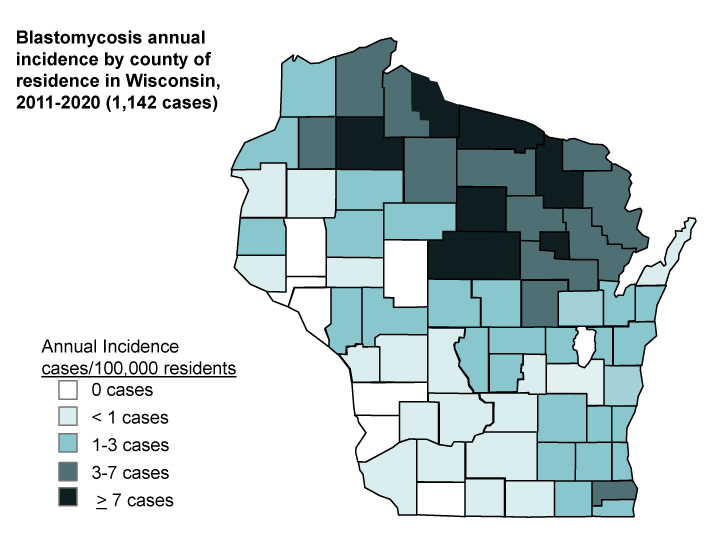
Lincoln County Health Department would like to remind community members of the risk of Blastomycosis (or “Blasto”). Although the risk of getting this fungal infection is low, every year there are individuals in Lincoln County who get Blastomycosis. Lincoln County is in the top five counties for the highest incidence rate of Blastomycosis in Wisconsin. Furthermore, from 2013-2022, 40 individuals in Lincoln County tested positive for Blastomycosis, 21 of which ended up hospitalized.
The fungus that causes Blastomycosis lives in moist soil with decaying wood and leaves. Wooded areas that are close to water are prime settings for the fungus to live. Only under exact conditions of humidity, temperature, and nutrition, can the fungus grow and produce spores that can be inhaled when soil is disturbed. With a warmer than usual late fall and early winter, we should be aware of the potential risk of conditions being favorable. People most likely also spent more time outdoors during these times.
It is important to know that Blastomycosis symptoms typically do not occur until 2-15 weeks after exposure. Symptoms can mimic other respiratory illnesses like the flu or acute bacterial pneumonia, making it difficult to diagnose. Usually, Blastomycosis symptoms resemble those of a lung infection, but it can affect other body systems including your skin and bones.
Blastomycosis symptoms may include:
Fever or chills
Cough
Shortness of breath
Chest or back pain
Feeling very tired
Skin sores that may look crusted and growing in size
About half of people infected will not have any symptoms. People with a weakened immune system or a chronic illness are more likely to show symptoms. Your risk increases if you participate in outdoor activities like farming, clearing brush, construction, riding all-terrain vehicles, gardening, hiking, hunting, and camping.
“Given the significant overlap with other respiratory illness symptoms, it is important for patients to follow-up with their primary care provider (PCP) or other provider if respiratory symptoms are not improving or worsen, and to be sure your provider is aware of activities that may increase your exposure to Blastomycosis,” said Dr. Michael Clark, MD, Lincoln County Health Department Medical Advisor.
If you are having these symptoms and think you may have Blastomycosis, be sure to talk to your healthcare provider right away. People are usually treated with antifungal medicine.
Early recognition and appropriate treatment can minimize illness. Although there are no formal recommendations to prevent Blastomycosis, if you have a weakened immune system or are elderly, you may want to consider wearing a dust mask when taking part in activities in which the soil is disturbed or avoiding these activities all together.
A Blastomycosis: Trends in Lincoln County 2013-2022 data brief was published last year; it can be found at: co.lincoln.wi.us/health/page/blastomycosis-blasto.
If you have questions or concerns, contact the Lincoln County Health Department at 715.536.0307.
More information is also available at the Wisconsin Department of Health Services website: dhs.wisconsin.gov/disease/blastomycosis.htm.
